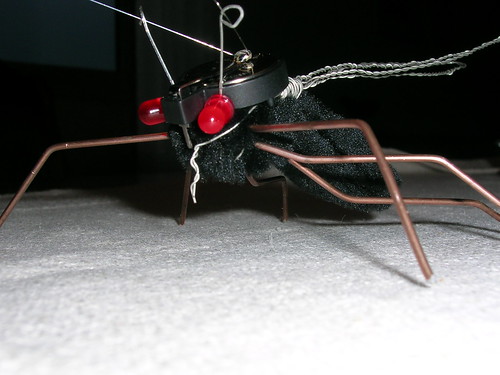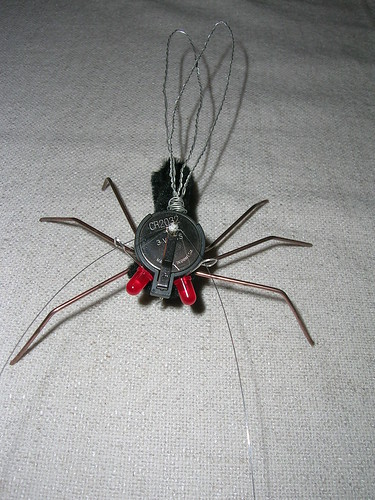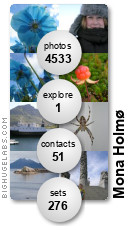 Tomorrow my colleagues and I will attend the Ecsite Conference in Lisbon. I look forward to days filled with inspiring talks about Science Center topics, and hope to bring back home some new ideas for a small Science Center up north. I also look forward to meeting Science Center colleagues from Europe and elsewhere. If you are going there, and are reading this, I would love to meeting you there!
Tomorrow my colleagues and I will attend the Ecsite Conference in Lisbon. I look forward to days filled with inspiring talks about Science Center topics, and hope to bring back home some new ideas for a small Science Center up north. I also look forward to meeting Science Center colleagues from Europe and elsewhere. If you are going there, and are reading this, I would love to meeting you there!
May 30, 2007
18th Ecsite Annual Conference
 Tomorrow my colleagues and I will attend the Ecsite Conference in Lisbon. I look forward to days filled with inspiring talks about Science Center topics, and hope to bring back home some new ideas for a small Science Center up north. I also look forward to meeting Science Center colleagues from Europe and elsewhere. If you are going there, and are reading this, I would love to meeting you there!
Tomorrow my colleagues and I will attend the Ecsite Conference in Lisbon. I look forward to days filled with inspiring talks about Science Center topics, and hope to bring back home some new ideas for a small Science Center up north. I also look forward to meeting Science Center colleagues from Europe and elsewhere. If you are going there, and are reading this, I would love to meeting you there!
Blinky Mosquito 1st edition

 The other day I made the Blinky Mosquito I had planned to. It turned out rather well, but I will change the design a bit to make it easier for small hands to make. I soldered all the electronic, and used string to attach the legs and the wings (because I didn't have any glue available, will use hotglue next time). I tried using a pantyhose to make the wings more correct, drawing veins onto it. But my string was to soft, and the wings collapsed. So for the next time, the string must be less flexible. If you have any suggestions to modifications, please send me a note :)
The other day I made the Blinky Mosquito I had planned to. It turned out rather well, but I will change the design a bit to make it easier for small hands to make. I soldered all the electronic, and used string to attach the legs and the wings (because I didn't have any glue available, will use hotglue next time). I tried using a pantyhose to make the wings more correct, drawing veins onto it. But my string was to soft, and the wings collapsed. So for the next time, the string must be less flexible. If you have any suggestions to modifications, please send me a note :)
May 22, 2007
Life in a nest box
 There has been major changes in our nest box since I last wrote about it. A few days after we had put it up in the tree, we had to do some changes. The battery supply turned out to be unsufficient, and we had supply the camera with a wired supply instead. When doing this, we discovered a nest in the box, and got both excited and worried. Would our fixin' make the birds leave the nest? But luckily, the birds stayed and we got great images from the tiny home. It was a couple of Great Tits (I can't believe I just wrote that!) that had settled down at our humble extension of the Planetarium.
There has been major changes in our nest box since I last wrote about it. A few days after we had put it up in the tree, we had to do some changes. The battery supply turned out to be unsufficient, and we had supply the camera with a wired supply instead. When doing this, we discovered a nest in the box, and got both excited and worried. Would our fixin' make the birds leave the nest? But luckily, the birds stayed and we got great images from the tiny home. It was a couple of Great Tits (I can't believe I just wrote that!) that had settled down at our humble extension of the Planetarium. Ok, this was May 9th. One week later we discovered the first eggs, and right now there are eight of them. One bird stays with the eggs almost constantly, while the other one brings food to the nesting one. According to experts we can expect hatching after 13-17 days, which means at the end of the month or early June. Exciting days ahead!
Ok, this was May 9th. One week later we discovered the first eggs, and right now there are eight of them. One bird stays with the eggs almost constantly, while the other one brings food to the nesting one. According to experts we can expect hatching after 13-17 days, which means at the end of the month or early June. Exciting days ahead!May 21, 2007
Back from a week in Lofoten
May 09, 2007
The International Polar Year
 March 1st the International Polar Year was launched, running till March 1st 2009. IPY is a large scientific programme organized through the International Council for Science (ICSU) and the World Meteorological Organization (WMO).
March 1st the International Polar Year was launched, running till March 1st 2009. IPY is a large scientific programme organized through the International Council for Science (ICSU) and the World Meteorological Organization (WMO).It is actually the fourth Polar Year, the previous ones were in 1882-3, 1932-3, and 1957-8. And this time the workforce and money put into it is bigger scaled than ever. More than 200 projects, 50 000 researchers and 60 countries are collaborating to give us new knowledge about the atmosphere, ice, land, oceans, people and space. It's a long year, you might say, but it is two years on purpose. This way the scientists will get two field seasons both in the Arctic and the Antarctic.
IPY has four headlines or urgencies as they call it; Changing Snow and Ice, Global Linkages, Neighbours in the North and Discovery.
In addition to the research program, IPY also focuses on public awareness and education. Lots of activities are launched at the international site, and also at various national sites (Norway, Australia, Canada, France, Germany, Russia, Spain, Sweden, United States, others).
 My Science Center is involved in a project called SciencePub, focusing on "Arctic Natural Climate and Environmental Changes and Human Adaptation: From Science to Public awareness".
My Science Center is involved in a project called SciencePub, focusing on "Arctic Natural Climate and Environmental Changes and Human Adaptation: From Science to Public awareness". This is a project where many different institutions collaborate; Norges geologiske undersøkelse, Bergen Vitensenter, Høgskolen i Oslo, Nordnorsk Vitensenter, Norsk Polarinstitutt, Universitetet for miljø og biovitenskap, Universitetet i Bergen, Universitetet i Tromsø and Vitensenteret i Trondheim in Norway, as well as The Science Academies in Petrozavodsk, Moscow and St. Petersburg and København Universitet.
Right now the scientist are working in the field both on land and at sea, in Norway, Russia, Greenland, the Fram Strait and Svalbard. At the end of September the results from this first field season should start coming, and I will report more from SciencePub then.
May 08, 2007
Bill Gates Trust Fund secures the Svalbard Global Seed Vault
The region of my Science Center is the largest in Norway. Situated in Tromsø, our region reaches 1200 km south, 900 km east and 1800 km north of Tromsø. Our region covers 30% of Norway's land area, but only 10% of the population. To the north we have to travel two hours by plane, if we wish to visit the local school at Longyearbyen, situated at 78 degrees North at the Svalbard archipelago. Going there we need to pay attention to the cold and dark winters, and the Polar Bear. But despite the harsh conditions, it is a wonderful place to be. There is nothing like it, and you have to see it for yourself, I do not know how to describe it the way it deserves to.
 Svalbard has had some news coverage lately. The Svalbard Global Seed Vault, nicknamed the "Doomsday Vault" by the media, is being built as we speak, outside Longyearbyen at an abandoned mine. The Arctic Seed Vault will rescue and store 95% of the biological diversity of the world's food crops, and will function as a backup for many of the international gene banks around the world. Several gene banks are vulnerable because of inadequate maintenance capacity, natural disasters or conflicts.
Svalbard has had some news coverage lately. The Svalbard Global Seed Vault, nicknamed the "Doomsday Vault" by the media, is being built as we speak, outside Longyearbyen at an abandoned mine. The Arctic Seed Vault will rescue and store 95% of the biological diversity of the world's food crops, and will function as a backup for many of the international gene banks around the world. Several gene banks are vulnerable because of inadequate maintenance capacity, natural disasters or conflicts.
The Seed Vault is organized and run by the Global Crop Diversity Trust, which has recieved £ 16.8 million from The Bill & Melinda Gates Foundation and £ 4.2 million in matching funds from the Minestry of Foreign Affairs. This is sufficient to deposit 450 000 distinct seed samples in the Svalbard Vault, securing 21 of the world's most important food crops. The Trust was founded by the UN Food and Agricultural Organisation and Biodiversity International, aiming to conserve the biological diversity of food crops in developing countries.
 Svalbard has had some news coverage lately. The Svalbard Global Seed Vault, nicknamed the "Doomsday Vault" by the media, is being built as we speak, outside Longyearbyen at an abandoned mine. The Arctic Seed Vault will rescue and store 95% of the biological diversity of the world's food crops, and will function as a backup for many of the international gene banks around the world. Several gene banks are vulnerable because of inadequate maintenance capacity, natural disasters or conflicts.
Svalbard has had some news coverage lately. The Svalbard Global Seed Vault, nicknamed the "Doomsday Vault" by the media, is being built as we speak, outside Longyearbyen at an abandoned mine. The Arctic Seed Vault will rescue and store 95% of the biological diversity of the world's food crops, and will function as a backup for many of the international gene banks around the world. Several gene banks are vulnerable because of inadequate maintenance capacity, natural disasters or conflicts.The Seed Vault is organized and run by the Global Crop Diversity Trust, which has recieved £ 16.8 million from The Bill & Melinda Gates Foundation and £ 4.2 million in matching funds from the Minestry of Foreign Affairs. This is sufficient to deposit 450 000 distinct seed samples in the Svalbard Vault, securing 21 of the world's most important food crops. The Trust was founded by the UN Food and Agricultural Organisation and Biodiversity International, aiming to conserve the biological diversity of food crops in developing countries.
Nest box with a peep hole
 Last week I built a nest box for the Science Center. It was the ordinary type, with a drilled opening suitable for Pied Flycatcher (Ficedula hypoleuca/Svarthvit fluesnapper) and Great Tit (Parus major/Kjøttmeis). But I did one change to the prototype, I made it 10 cm taller to make room for a wireless webcam.
Last week I built a nest box for the Science Center. It was the ordinary type, with a drilled opening suitable for Pied Flycatcher (Ficedula hypoleuca/Svarthvit fluesnapper) and Great Tit (Parus major/Kjøttmeis). But I did one change to the prototype, I made it 10 cm taller to make room for a wireless webcam.The plan is to monitor the life inside a birdcage and display it on our official webpage. But to succeed, a squatter has to like the facilities we offer, and not destroy the surveilance camera we have put inside.
Instead of using a regular webcam, we decided to purchase a special surveilance camera. It is tiny (3 x 2 cm), runs on a 9V battery and works well with low light conditions. And hopefully it will tolerate the varying conditions outdoors. The drawback is; it is an analog camera. We need to process the signal to make a digital version for the web, and right now we are waiting for the right gadget to arrive by mail.  Hopefully it will work when we get it. And hopefully we will fix it before the (if any) action starts outside. We are a bit late. The breeding season is just around the corner, if it hasn't started already. We are crossing our fingers for a pair of latecomers, who will find our accomodation suitable to hatch at.
Hopefully it will work when we get it. And hopefully we will fix it before the (if any) action starts outside. We are a bit late. The breeding season is just around the corner, if it hasn't started already. We are crossing our fingers for a pair of latecomers, who will find our accomodation suitable to hatch at.
 Hopefully it will work when we get it. And hopefully we will fix it before the (if any) action starts outside. We are a bit late. The breeding season is just around the corner, if it hasn't started already. We are crossing our fingers for a pair of latecomers, who will find our accomodation suitable to hatch at.
Hopefully it will work when we get it. And hopefully we will fix it before the (if any) action starts outside. We are a bit late. The breeding season is just around the corner, if it hasn't started already. We are crossing our fingers for a pair of latecomers, who will find our accomodation suitable to hatch at.May 01, 2007
Blinkybugs, my first attempt at making one
 The other day I made my first blinkybug. All I want to do now, is make another one and improve my own design.
The other day I made my first blinkybug. All I want to do now, is make another one and improve my own design.But what is a blinkybug?
I first read about them in Make: magazine and thought they were SO cute. Just recently I was reminded of them when I read about them in the Make: blog, with a link to a site called Instructables. The version described here is a simplified soldering-free one, and is said to take ten minutes to make if you have everything you need ready and handy. I must admit, I spent more time doing it. But I did some detours on the way. I checked the inventor Ken Murphy's own site called Blinkybug.com, and studied the photos of the various versions he had made. I decided to go for the soldered version, but I didn't have a battery holder. To manage the soldering without the battery holder, I realized (after some trial and error) that I would need three hands, and I had no one around to lend me one extra. After some testing with the two I have I decided to go for hotglue instead. My bug didn't look as good as Ken Murphy's ones, but I thought it was ok, considering it being my first trial.
I will certainly make more of these, and will also try to come up with some alternative designs. A sub-arctic mosquito needs to be made, being the most numerous animal in Samiland (within my Science Center's region), and outbeating the reindeer multiple times. That would be a nice signature blinkybug for the Science Center of Northern Norway. I will keep you posted on how it works out. There are some photos of blinkybug(s) at Flickr, and the creativity is great out there!
If you want to try to make one yourself, just use the decription at Instructables. I will try the soldered version, and have found battery holders at Elfa (Northern Europe Electronics Supplier). You also get cheaper batteries here, if you buy a bulk of ten or 40 you save a lot.
If you know of other serious, cheap and swift suppliers worldwide, please send me a note about it.
Subscribe to:
Comments (Atom)





